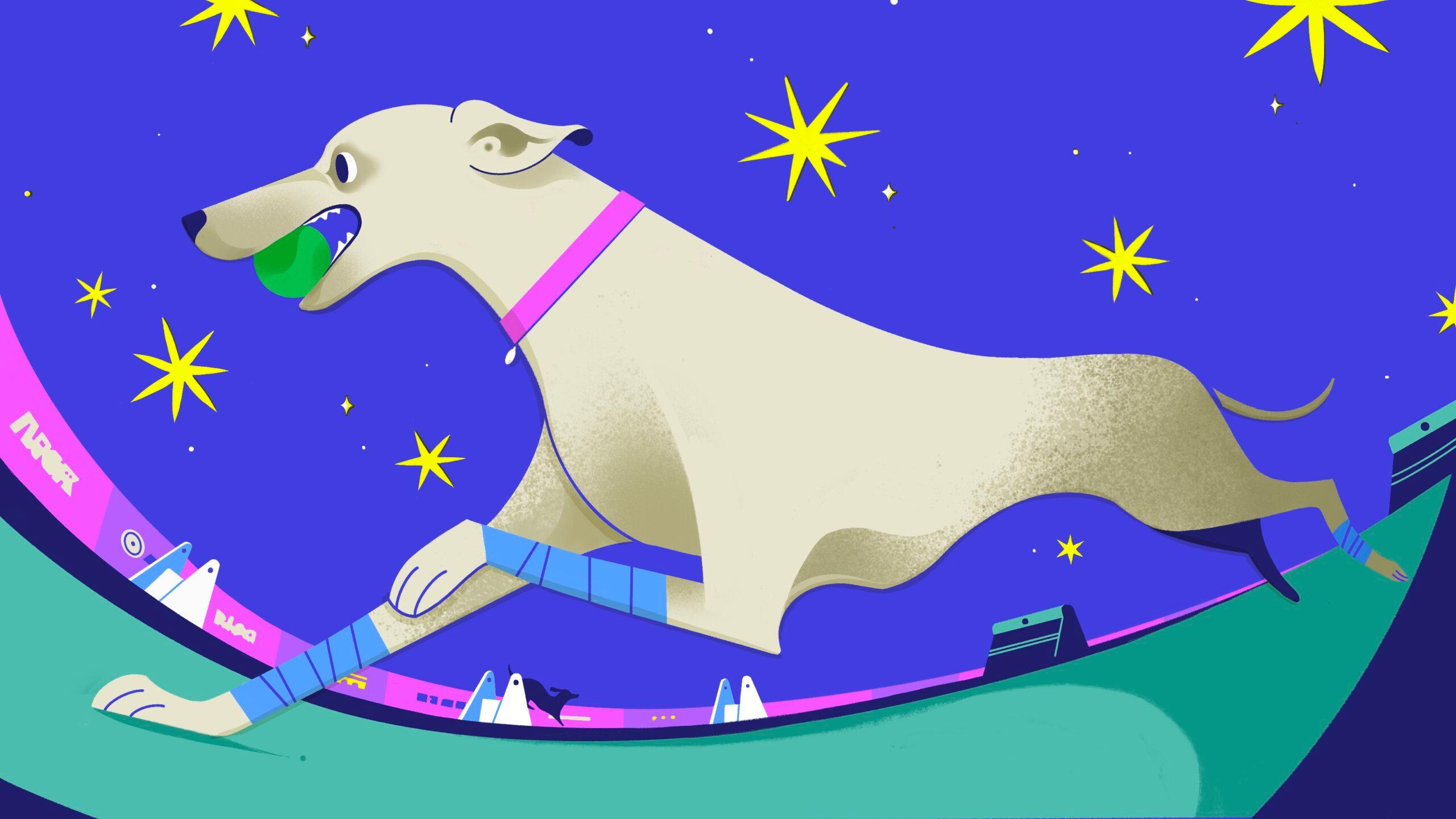Blur of Fur
You might be more familiar with the tame austerity of the Westminster Dog Show, but in the canine world, there’s no competition faster and more fun than flyballThe Ringer hereby declares this Wednesday, August 19, 2020, to be Dog Day. We have no concrete reason for doing so, other than that dogs are great and ought to be celebrated. We hope you agree.
As the sound of barking drowns out the crowd noise, two groups of people huddle with their four-legged teammates, some of whom are far too excited to sit still. Hundreds of spectators line the course inside a hangar-like complex in Northern France. In the bottom lane is a Belgian squad called the Flying Dragons; in the top is the American club Fur Fun. As the lead runners from both teams yank the arms of the handlers holding them back, a set of timing lights blinks from red, to yellow, to green. And then, bang—the canines launch into a long straightaway lined with four jumps.
Running the first leg for Fur Fun is a border collie–whippet mix named Envy, who helps her team jump out to a big lead. The dog clears the hurdles with startling ease before reaching a spring-loaded box. Hitting the contraption releases a tennis ball that the pooch grabs with her mouth. She then quickly turns and heads back through the course. As Envy crosses the finish line, which is monitored by an electronic sensor, a border–Jack Russell terrier mix named Elphaba begins the up-and-back sprint. It’s a delirious experience, dogs ravenously hurtling through the air, violently flinging themselves at tennis balls and making 180-degree turns that seem to defy physics, all amid a cacophony of crowd noise and excited yapping. And it lasts only about 16 seconds.
I love watching my dog chase after a tennis ball. But until recently, I didn’t realize that there was a competitive version of that joyful act. It’s called flyball, and at its highest levels, it’s one of the most purely exhilarating sports on earth. “I like that amped-up environment more than a prim and proper dog show,” says Steve Corona, chairman of the North American Flyball Association (NAFA). “It’s so unlike anything else. I don’t even think the videos we have do it that much justice.”
Every flyball highlight reel is a blur of fur. To fully grasp how fast Fur Fun’s border mixes—Trinity and Homestar rounded out the quartet—were running in the best-of-five heat finals of the inaugural Flyball Open World Cup two summers ago, you need to slow a video of their performance down to half-speed. Flyball is like a combination of a drag race, a track meet, and an Olympic swimming event.
Leerie Jenkins, a member of Fur Fun, sums it up in even simpler terms: “It’s an over-glorified game of fetch with your dog.” And therein lies the beauty of flyball: It’s fun, stuck on fast-forward. And the barrier for entry is only as high as one of the short jumps found on any of the sport’s courses. It’s as inclusive as any competitive pursuit in the dog world.
“There’s nothing in flyball about where your dog came from, who bred it, who its champion parents are,” says Fur Fun co-owner and captain Julie Jenkins. “There are no pedigrees kept in flyball official record books. And it’s purely based on what you can do. And so you are measured on the dog in front of you rather than the dog’s fancy paperwork that goes along with it.” And most important: “It’s a sport that you cannot compete in as just one individual. You need a team.”
Flyball is not just a sport for dogs. It’s a sport for their owners too. Each race requires at least four canine participants and four handlers. (There are also tennis ball loaders and runners who pick up loose balls and reset downed jumps, in addition to line and box judges.) Flyball success, Corona says, is predicated on the “bond you create with your dog. You’re so in sync. You know the minute they’re having an off day.”
The basic mechanics of flyball are simple: It’s a relay race conducted on a 51-foot course that features four identical jumps placed 10 feet apart. The hurdles range from 7 to 14 inches tall; that number is determined by the shoulder height of the team’s shortest dog. Coordinating the quick and delicate passes between dogs at the start/finish line is a skill. “A perfect pass,” says Joy Adiletta, who owns Engage Flyball in Seattle, “would be an inch between the noses.”
To Julie Jenkins, the most difficult aspect of flyball for dogs is being able to focus in a highly distracting setting. “Every dog will react to that pressure differently,” she says. “Some dogs are like, ‘Oh my God, there’s so much barking and it’s so loud, and there’s other dogs running. I’m nervous. I’m scared. I can’t do anything. I’m just going to sit here and be shut down.’ Or the opposite end of the spectrum. The dog that is like, ‘It is so loud and there is so much going on, and party!’” For humans, there are other challenges. “I like to say that people that play flyball have to have a bare minimum of sociability that allows them to work with one or two other people,” says Jenkins, whose Fur Fun teammate is her husband, Leerie. “And so it weeds out, a little bit, the people that are maybe a little less fun to do things with.”
All dogs, including those with three legs or vision loss, are eligible to play flyball. Generally, the two most competitive NAFA team classifications are regular (no breed restrictions) and multibreed (each of the four dogs must be a different breed or three breeds and one mixed breed). Fast and athletic breeds like border collies, whippets, terriers, shepherds, and retrievers—or mixes of those—are typically among the best racers. Intelligence helps, but it doesn’t always result in a canine flyball wiz. “Border collies are highly trainable and willing to do [tasks] over and over again,” Julie Jenkins says. “There are some dogs that are really smart, so smart that they’re like, ‘No, I did that five times. Why would I want to do it again? I’m going to go sit down. If you want the ball so much, you go get it.’ And that’s not necessarily because they’re dumb.”
Flyball traces its origins back to scent hurdle racing, a sport in which dogs run through a course and sniff out and then retrieve dumbbells. The dumbbells eventually gave way to tennis balls. By the early 1970s, an obedience trainer named Herbert Wegner developed a rudimentary flyball box. On November 4, 1976, he appeared as a guest on The Tonight Show. Before introducing him, host Johnny Carson addressed the audience: “We have the first annual, and possibly the last annual, dog relay races.”
In Wegner’s short interview, during which he sat between Carson and Ed McMahon, the trainer extolled the virtues of dog racing, saying that any breed could do it, “from a Great Dane down to an Irish wolfhound.” Soon, the cameras cut to a course lined with jumps. Carson presided over the races. The first was a scent hurdling demonstration. But sure enough, the second featured Wegner’s patented boxes—each was emblazoned with “Flyball Races.”
As a variety of dogs sprinted forward, cleared the jumps, and leaped onto the boxes—which sent balls flying into the air and into their mouths—Carson offered bemused commentary. “That’s the craziest thing I’ve ever seen,” he said. When the race was over, Carson shook Wegner’s hand, stuck an orange ball in his own mouth, and ran the course himself, hopping over every jump with ease.
Over the next decade, perhaps spurred by flyball’s appearance on The Tonight Show, the sport became far more organized than it was in its earliest days. The first flyball tournament was held in 1983. Two years later, Mike Randall, the first executive director of NAFA, wrote the first official flyball rulebook.
Since then, flyball has attracted thousands of participants. The advent of precise electronic timing helped further legitimize the sport, which has evolved into the version of it that we see today: rocket-fueled fetch. In 2016, Border Patrol, a team from Ontario, completed a heat in 14.433 seconds, a regular world record. (The multibreed world record is 14.852.) Last year, NAFA vice chairman Emma Mak says that a total of 6,656 teams raced in 304 events and 4,378 dogs earned at least one point. (That means that they were a member of a team that completed at least one heat in less than 32 seconds.)
Julie Jenkins has been involved in flyball since the 1990s. (Her mother, Deb Norman, is a Fur Fun co-owner.) As a teenager in Philadelphia back then, Jenkins began training a border collie named Sprint. “To have a dog like her that was such a sponge, so very smart, trainable, athletic, behaviorally, mentally, physically sound—there was nothing we couldn’t do,” says Jenkins, who at one point appeared with Sprint on Live With Regis and Kelly. “I would be like, ‘Oh, I wonder if I could teach her this.’ And I would go and teach it to her in like a day, and then on to the next thing the next day. And so just having that dog at the right time in my life and what I was able to teach her and do with her opened my mind up to what became my career.”
Sprint raced for more than a decade before retiring. “She fetched the paper every morning from the end of the driveway until she passed away,” says Jenkins, who’s now living outside Greensboro, North Carolina, where her family owns and operates a 15,000-square-foot dog training and events center. But retirement isn’t some forlorn occasion of lost youth. These are dogs we’re talking about—there aren’t many Brett Favres in this sport. “Even when a dog is retired from competitive sports, they, at least in the world that I live in, they still live a very enriched life. And I don’t think they miss it. I don’t think they’re getting home like, ‘Man, I wish I could play flyball.’ I’m 100 percent sure that dogs live in the moment of what’s happening right now.”
Today, Sprint’s spirit lives on. Her descendants are still playing flyball. “She was born in 1995,” says Jenkins, whose team won the CanAm Classic—the sport’s Super Bowl—in 2018 and has also notched multiple NAFA titles. “And all of my current dogs are related to her.”
While the sport is a proud melting pot of all kinds of dogs, breeders do plan litters with flyball in mind. One of those specialty mixed-breed puppies—border-whippets are common—can, well, fetch several thousand dollars. “There are waiting lists,” says Corona, who owns a dog boarding and training center outside Austin.
Here’s where I point out that in flyball there are no money prizes. But even though that’s the case, elite flyball racers take their sport seriously. They train nonstop. They keep their dogs on cardio regimens that include leash walking, running on a treadmill, and swimming. They do balance and coordination drills. “My dogs learn how to do a couple of motions like going from a stand to a down and back to a stand again,” Jenkins says, “and things like turning around in a tight circle, [and] doing figure eights at a trot or a walk.”
Occasionally, like any high-level athletes, the dogs suffer injuries. Doggy aches and pains can range from broken toes and nails, to burned paw pads caused by repeatedly hitting the box hard, to torn ligaments. Just like NBA players, many pups get their legs wrapped with tape for stability.
But even as flyball has grown more and more competitive, it remains, above all else, fun. Adiletta calls it “the kegger of dog sports” for a reason. There are no riches to be had, but that makes it no less rewarding.
“It’s very edifying to have a group of close friends that you share in success, and failures, and training, and the camaraderie, and the silliness, and food,” says Leerie Jenkins. “It’s the only dog sport you get to play with your dogs, your friends, and your friends’ dogs.”
In the mid-2000s, Steve Corona rescued a border collie named Cayenne from a parking lot. She had played flyball for more than a decade. In 2018, Cayenne achieved the third tier of grand champion status, given to dogs that have scored 50,000 or more career points—the 500 Home Run Club for dogs. That same year, she won NAFA Region 5 MVP honors and became a sort of canine Lou Gehrig, earning the Iron Dog Award, which is presented to racers that have scored at least a single point in 10 consecutive years.
After her MVP season, Cayenne retired from the sport. It was just time. There’s no use in unnecessarily pushing an aging pup. “We don’t want to take our dogs that far,” Corona says. Still, it wasn’t easy for the dog and her owner. “That next tournament after the last one is just brutal,” he says.
That year, Cayenne was diagnosed with lymphocytic leukemia. But Cayenne has outlived her prognosis. Corona says that she’s “the princess” among his six dogs. Before COVID-19 shut down the sport, he was still taking her to flyball events. “She still wants to go over the jumps,” Corona says proudly. And she still loves her tennis ball.


